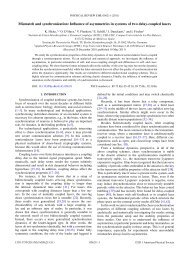DBI Analysis of Open String Bound States on Non-compact D-branes
DBI Analysis of Open String Bound States on Non-compact D-branes
DBI Analysis of Open String Bound States on Non-compact D-branes
Create successful ePaper yourself
Turn your PDF publications into a flip-book with our unique Google optimized e-Paper software.
CHAPTER 3. SUPERSTRINGS 51gives back our 64 massless states. These gauge fields are <str<strong>on</strong>g>of</str<strong>on</strong>g>ten called Ram<strong>on</strong>d-Ram<strong>on</strong>dfields for obvious reas<strong>on</strong>s.Type IIBThe type IIB theory results from choosing identical chiralities for the R sector <str<strong>on</strong>g>of</str<strong>on</strong>g> bothleft- and right-movers. The massless states <str<strong>on</strong>g>of</str<strong>on</strong>g> this theory can also be found in 3.1. We<strong>on</strong>ly c<strong>on</strong>sider <strong>on</strong>e chirality, namely R.The c<strong>on</strong>tent <str<strong>on</strong>g>of</str<strong>on</strong>g> the (NS,NS) sector is exactly the same as for the Type IIA theory,and so also here we find back our g µν , B µν and Φ fields.The c<strong>on</strong>tent <str<strong>on</strong>g>of</str<strong>on</strong>g> the (R,NS) and (NS,R) sectors is also the same, except for the factthat in the Type IIB theory the dilatinos and gravitinos have the same chirality.The (R,R) sector gives rise to quite different Ram<strong>on</strong>d-Ram<strong>on</strong>d gauge fields though,given that this time both chiralities are the same. It turns out that the massless TypeIIB (R,R) states can be regrouped in a zero-form scalar gauge field A, a two-formgauge(field A µν and a self-dual four-form gauge field A µνρσ . Note that also this time,8) (0 + 8)2 +1 82(4)= 1 + 28 + 35 = 64, as it <str<strong>on</strong>g>of</str<strong>on</strong>g> course should.Type IIAType IIB|0〉 RL × |0〉 ¯R |0〉 RL × |0〉 RR˜bi |0〉− 1 NSL × b j |0〉2− 1 NSR˜bi |0〉− 1 NSL × b j |0〉22− 1 NSR2˜bi |0〉− 1 NSL × |0〉 RR˜bi |0〉− 1 NSL × |0〉 RR22|0〉 ¯RL × b i |0〉− 1 NSR |0〉 RL × b i |0〉− 1 NSR22Table 3.1: Massless states for both Type II theories. The subscript L denotes left-movers,R stands for right-movers.Other superstring theoriesThe laws <str<strong>on</strong>g>of</str<strong>on</strong>g> logic dictate that if there are two Type II theories, there must be at least<strong>on</strong>e Type I theory. There indeed is such a theory, and it is a theory <str<strong>on</strong>g>of</str<strong>on</strong>g> unorientedstrings (remember: no B µν field, or any other antisymmetric state). For the sake <str<strong>on</strong>g>of</str<strong>on</strong>g>completeness we also menti<strong>on</strong> the two heterotic string theories: E 8 × E 8 and SO(32).These are theories in which <strong>on</strong>e <str<strong>on</strong>g>of</str<strong>on</strong>g> the left- and right-moving modes <str<strong>on</strong>g>of</str<strong>on</strong>g> the closed stringis supersymmetric, and the other <strong>on</strong>e is bos<strong>on</strong>ic. The names <str<strong>on</strong>g>of</str<strong>on</strong>g> these theories corresp<strong>on</strong>dto their symmetry groups.3.5 SummaryThis chapter has given a very brief introducti<strong>on</strong> to the superstring, focusing mainly<strong>on</strong> the c<strong>on</strong>structi<strong>on</strong> <str<strong>on</strong>g>of</str<strong>on</strong>g> the open string spectrum and how to get rid <str<strong>on</strong>g>of</str<strong>on</strong>g> the problems
















